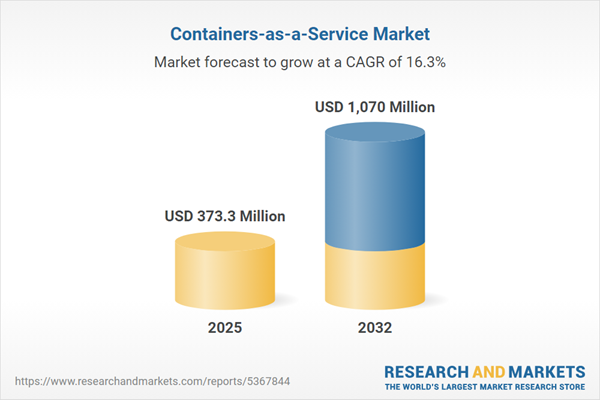Speak directly to the analyst to clarify any post sales queries you may have.
The Containers-as-a-Service market is emerging as an essential component of digital transformation strategies, enabling organizations to enhance application deployment and operational agility in complex cloud-native environments. Senior decision-makers will benefit from understanding how technological advancements and global forces are converging to inform the future of containerized application delivery.
Market Snapshot: Dynamic Growth in the Containers-as-a-Service Market
The Containers-as-a-Service market grew from USD 319.92 million in 2024 to USD 373.30 million in 2025 and is projected to reach USD 1.07 billion by 2032, reflecting a CAGR of 16.32%. Strong adoption is driven by rapid enterprise demand for scalable, flexible infrastructure, accelerated by the need for streamlined development pipelines and effective resource management. This sustained market trajectory demonstrates enterprises' increasing reliance on managed container platforms and evolving deployment models that support both innovation and operational resilience.
Scope & Segmentation of the Containers-as-a-Service Market
This report offers in-depth analysis across services, deployment strategies, organization sizes, industries, and global regions, enabling a nuanced view of competitive and operational dynamics.
- Service Offering: Container management, networking (including overlay and software defined networking), orchestration (Apache Mesos, Docker Swarm, Kubernetes with managed and self-managed options), security (identity management, network security, runtime, vulnerability management), and container storage solutions are covered.
- Deployment Model: Hybrid cloud, private cloud, and public cloud environments are examined for differences in resource control, compliance, and scalability.
- Organization Size: Segmentation by large enterprises and small and medium enterprises to highlight varying adoption drivers and solution preferences.
- End User Industry: In-depth insights for banking and financial services, healthcare and life sciences, information technology and telecom, manufacturing, and retail and e-commerce, each with distinct regulatory and operational needs.
- Regional Coverage: Comprehensive coverage of the Americas (with detailed analysis of North and Latin America), Europe, Middle East & Africa (including specific countries in each subregion), and Asia-Pacific (with key country markets).
- Company Developments: Trends and strategies of major vendors, including Amazon Web Services, Microsoft, Google, Alibaba Cloud, IBM, Oracle, VMware, Red Hat, Rancher Labs, and Docker, are assessed for innovation and market positioning.
Key Takeaways for Senior Decision-Makers
- Containers-as-a-Service accelerates digital transformation by standardizing deployment environments, boosting collaboration between development and operations, and supporting multi-cloud and hybrid strategies.
- Integration of microservices and DevOps, combined with innovations such as service meshes and declarative infrastructure, is streamlining application lifecycle management and improving system resilience.
- Vendors are differentiating platforms through built-in monitoring, security automation, and unified management dashboards, addressing compliance, governance, and operational challenges at scale.
- Hybrid deployment and organization size have a direct impact on solution selection; larger enterprises often tailor stacks, while smaller ones prefer preconfigured services for ease of adoption.
- Industry-specific requirements in sectors such as banking and healthcare elevate the significance of policy-driven governance and robust security frameworks to ensure data integrity and regulatory compliance.
- The competitive landscape features a blend of hyperscale providers, open source contributors, legacy vendors, and emerging startups, each contributing to innovation and ecosystem robustness.
Tariff Impact on Containers-as-a-Service Value Chain
Recent United States tariff policies have affected the market’s supply chain and cost structure, increasing hardware costs and prompting infrastructure providers to renegotiate contracts, focus on consumption-based pricing, and diversify supply sources. These adaptations have led to greater adoption of lightweight runtimes and serverless offerings, benefiting organizations by reducing fixed costs and supporting sustainability goals. The shift has reinforced the importance of strategic partnerships and flexible sourcing in maintaining operational resilience.
Methodology & Data Sources
This report is based on a mixed-method research framework, utilizing interviews with technology executives and solution architects, alongside comprehensive review of industry white papers, technical documentation, and public filings. Advanced statistical analysis and triangulation of academic and market data have been combined with expert validation and sector-specific case studies to ensure reliable, actionable market insights.
Why This Containers-as-a-Service Market Report Matters
- Enables leaders to shape strategies informed by nuanced segmentation, regional opportunities, and competitor activity.
- Helps organizations quickly align technology investments with key trends in hybrid cloud, multi-cloud, and DevOps-driven transformation.
- Supports proactive risk management through actionable intelligence on regulatory changes, supply chain impacts, and evolving security needs.
Conclusion
Containers-as-a-Service is reshaping enterprise IT strategies by delivering operational agility and enabling scalable, secure cloud-native solutions. This report provides strategic clarity for decision-makers seeking to leverage container ecosystems for future-ready transformation.
Additional Product Information:
- Purchase of this report includes 1 year online access with quarterly updates.
- This report can be updated on request. Please contact our Customer Experience team using the Ask a Question widget on our website.
Table of Contents
3. Executive Summary
4. Market Overview
7. Cumulative Impact of Artificial Intelligence 2025
Companies Mentioned
The companies profiled in this Containers-as-a-Service market report include:- Amazon Web Services, Inc.
- Microsoft Corporation
- Google LLC
- Alibaba Cloud Computing Co., Ltd.
- International Business Machines Corporation
- Oracle Corporation
- VMware, Inc.
- Red Hat, Inc.
- Rancher Labs, Inc.
- Docker, Inc.
Table Information
| Report Attribute | Details |
|---|---|
| No. of Pages | 195 |
| Published | November 2025 |
| Forecast Period | 2025 - 2032 |
| Estimated Market Value ( USD | $ 373.3 Million |
| Forecasted Market Value ( USD | $ 1070 Million |
| Compound Annual Growth Rate | 16.3% |
| Regions Covered | Global |
| No. of Companies Mentioned | 11 |









